End-To-End Hierarchical Relation Extraction for Generic Form Understanding
Tuan Anh Nguyen Dang,
Duc-Thanh Hoang,
Quang Bach Tran,
Chih-Wei Pan,
Thanh-Dat Nguyen
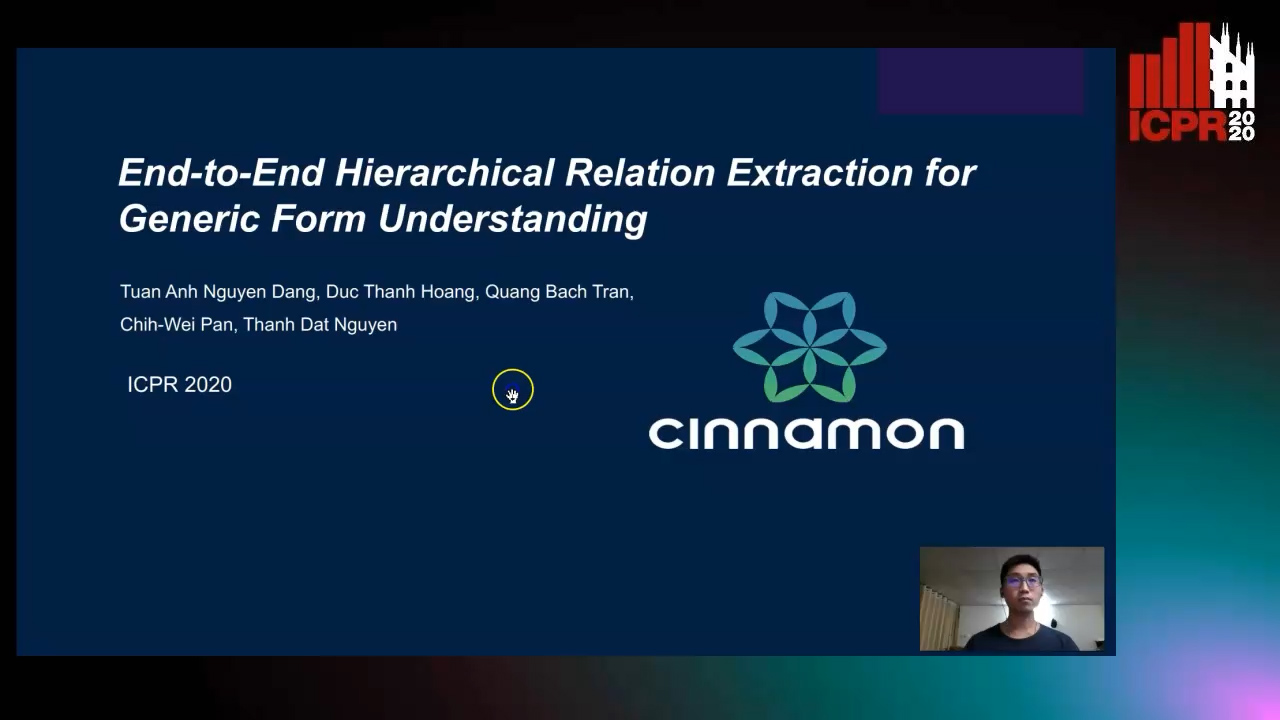
Auto-TLDR; Joint Entity Labeling and Link Prediction for Form Understanding in Noisy Scanned Documents
Similar papers
Named Entity Recognition and Relation Extraction with Graph Neural Networks in Semi Structured Documents
Manuel Carbonell, Pau Riba, Mauricio Villegas, Alicia Fornés, Josep Llados

Auto-TLDR; Graph Neural Network for Entity Recognition and Relation Extraction in Semi-Structured Documents
PICK: Processing Key Information Extraction from Documents Using Improved Graph Learning-Convolutional Networks
Wenwen Yu, Ning Lu, Xianbiao Qi, Ping Gong, Rong Xiao

Auto-TLDR; PICK: A Graph Learning Framework for Key Information Extraction from Documents
Abstract Slides Poster Similar
Multiple Document Datasets Pre-Training Improves Text Line Detection with Deep Neural Networks
Mélodie Boillet, Christopher Kermorvant, Thierry Paquet

Auto-TLDR; A fully convolutional network for document layout analysis
Combining Deep and Ad-Hoc Solutions to Localize Text Lines in Ancient Arabic Document Images
Olfa Mechi, Maroua Mehri, Rolf Ingold, Najoua Essoukri Ben Amara

Auto-TLDR; Text Line Localization in Ancient Handwritten Arabic Document Images using U-Net and Topological Structural Analysis
Abstract Slides Poster Similar
Text Baseline Recognition Using a Recurrent Convolutional Neural Network
Matthias Wödlinger, Robert Sablatnig
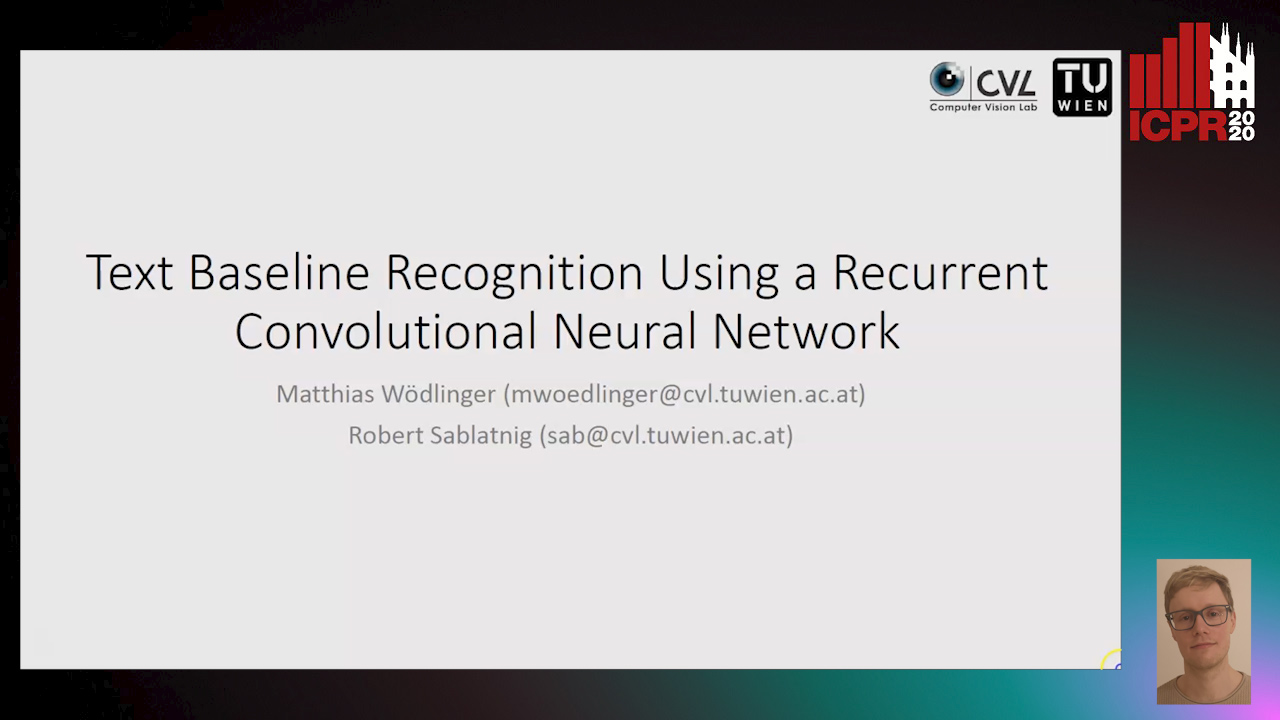
Auto-TLDR; Automatic Baseline Detection of Handwritten Text Using Recurrent Convolutional Neural Network
Abstract Slides Poster Similar
DUET: Detection Utilizing Enhancement for Text in Scanned or Captured Documents
Eun-Soo Jung, Hyeonggwan Son, Kyusam Oh, Yongkeun Yun, Soonhwan Kwon, Min Soo Kim
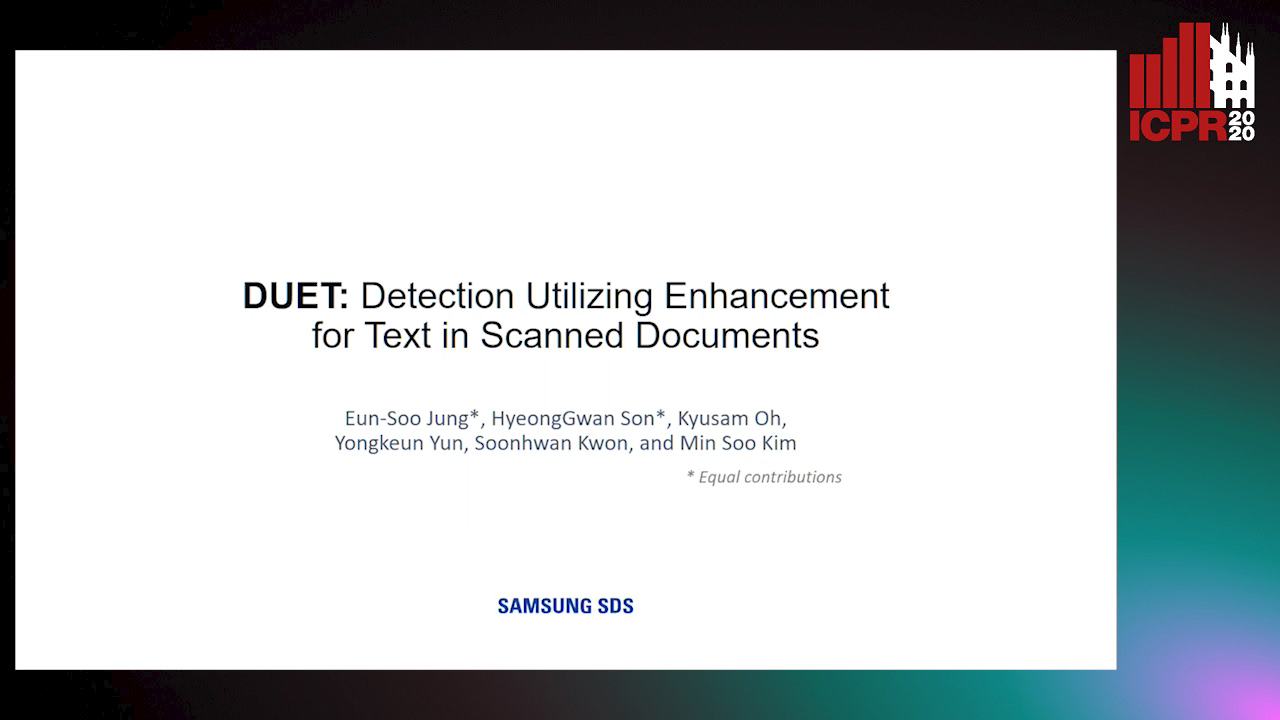
Auto-TLDR; Text Detection for Document Images Using Synthetic and Real Data
Abstract Slides Poster Similar
An Integrated Approach of Deep Learning and Symbolic Analysis for Digital PDF Table Extraction
Mengshi Zhang, Daniel Perelman, Vu Le, Sumit Gulwani

Auto-TLDR; Deep Learning and Symbolic Reasoning for Unstructured PDF Table Extraction
Abstract Slides Poster Similar
Segmenting Messy Text: Detecting Boundaries in Text Derived from Historical Newspaper Images

Auto-TLDR; Text Segmentation of Marriage Announcements Using Deep Learning-based Models
Abstract Slides Poster Similar
The HisClima Database: Historical Weather Logs for Automatic Transcription and Information Extraction
Verónica Romero, Joan Andreu Sánchez

Auto-TLDR; Automatic Handwritten Text Recognition and Information Extraction from Historical Weather Logs
Abstract Slides Poster Similar
Feature Embedding Based Text Instance Grouping for Largely Spaced and Occluded Text Detection
Pan Gao, Qi Wan, Renwu Gao, Linlin Shen

Auto-TLDR; Text Instance Embedding Based Feature Embeddings for Multiple Text Instance Grouping
Abstract Slides Poster Similar
Watch Your Strokes: Improving Handwritten Text Recognition with Deformable Convolutions
Iulian Cojocaru, Silvia Cascianelli, Lorenzo Baraldi, Massimiliano Corsini, Rita Cucchiara

Auto-TLDR; Deformable Convolutional Neural Networks for Handwritten Text Recognition
Abstract Slides Poster Similar
CDeC-Net: Composite Deformable Cascade Network for Table Detection in Document Images
Madhav Agarwal, Ajoy Mondal, C. V. Jawahar

Auto-TLDR; CDeC-Net: An End-to-End Trainable Deep Network for Detecting Tables in Document Images
Unsupervised deep learning for text line segmentation
Berat Kurar Barakat, Ahmad Droby, Reem Alaasam, Borak Madi, Irina Rabaev, Raed Shammes, Jihad El-Sana
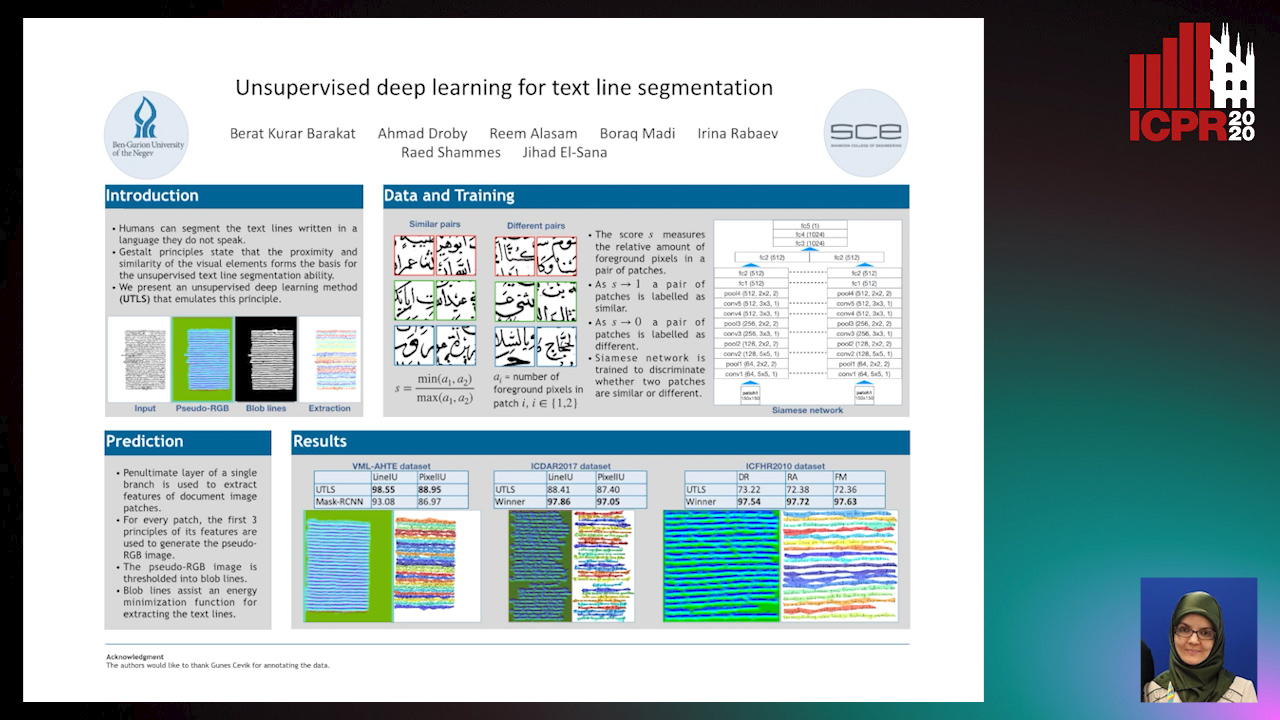
Auto-TLDR; Unsupervised Deep Learning for Handwritten Text Line Segmentation without Annotation
StrongPose: Bottom-up and Strong Keypoint Heat Map Based Pose Estimation

Auto-TLDR; StrongPose: A bottom-up box-free approach for human pose estimation and action recognition
Abstract Slides Poster Similar
Learning to Sort Handwritten Text Lines in Reading Order through Estimated Binary Order Relations
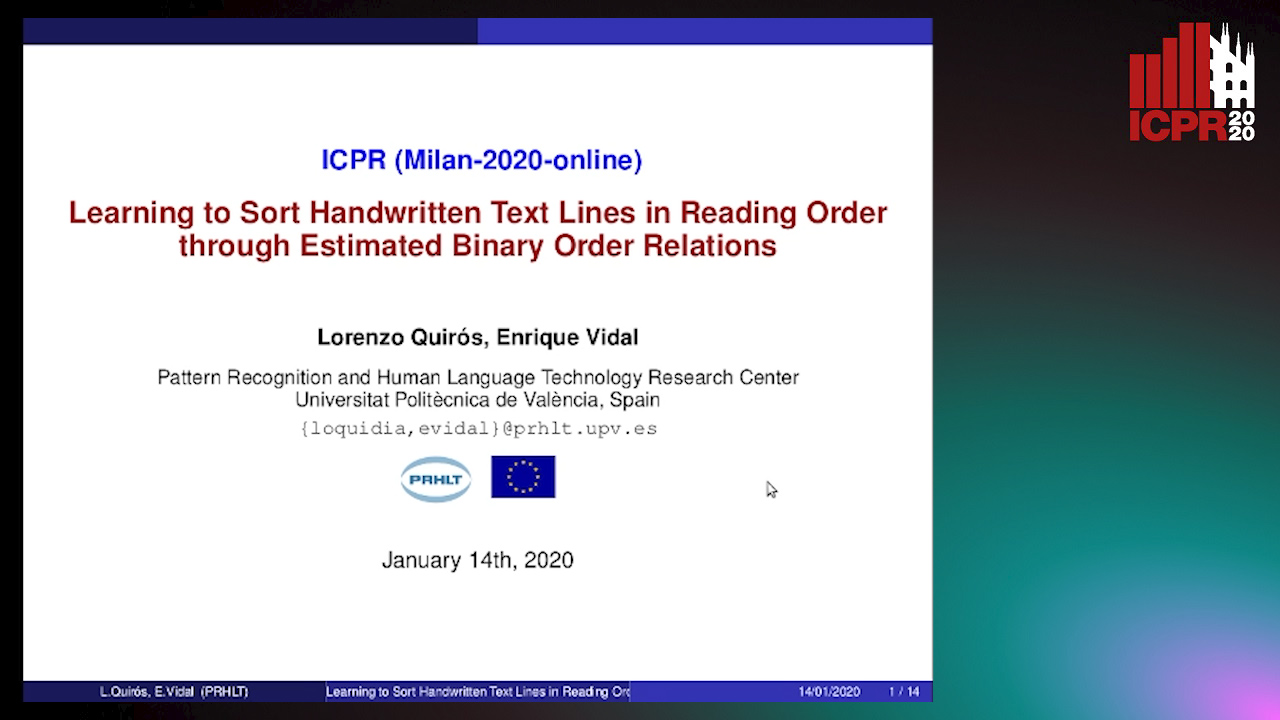
Auto-TLDR; Automatic Reading Order of Text Lines in Handwritten Text Documents
Multi-Modal Contextual Graph Neural Network for Text Visual Question Answering
Yaoyuan Liang, Xin Wang, Xuguang Duan, Wenwu Zhu

Auto-TLDR; Multi-modal Contextual Graph Neural Network for Text Visual Question Answering
Abstract Slides Poster Similar
Zero-Shot Text Classification with Semantically Extended Graph Convolutional Network
Tengfei Liu, Yongli Hu, Junbin Gao, Yanfeng Sun, Baocai Yin

Auto-TLDR; Semantically Extended Graph Convolutional Network for Zero-shot Text Classification
Abstract Slides Poster Similar
ID Documents Matching and Localization with Multi-Hypothesis Constraints
Guillaume Chiron, Nabil Ghanmi, Ahmad Montaser Awal

Auto-TLDR; Identity Document Localization in the Wild Using Multi-hypothesis Exploration
Abstract Slides Poster Similar
Dual Path Multi-Modal High-Order Features for Textual Content Based Visual Question Answering
Yanan Li, Yuetan Lin, Hongrui Zhao, Donghui Wang

Auto-TLDR; TextVQA: An End-to-End Visual Question Answering Model for Text-Based VQA
Efficient Grouping for Keypoint Detection
Alexey Sidnev, Ekaterina Krasikova, Maxim Kazakov
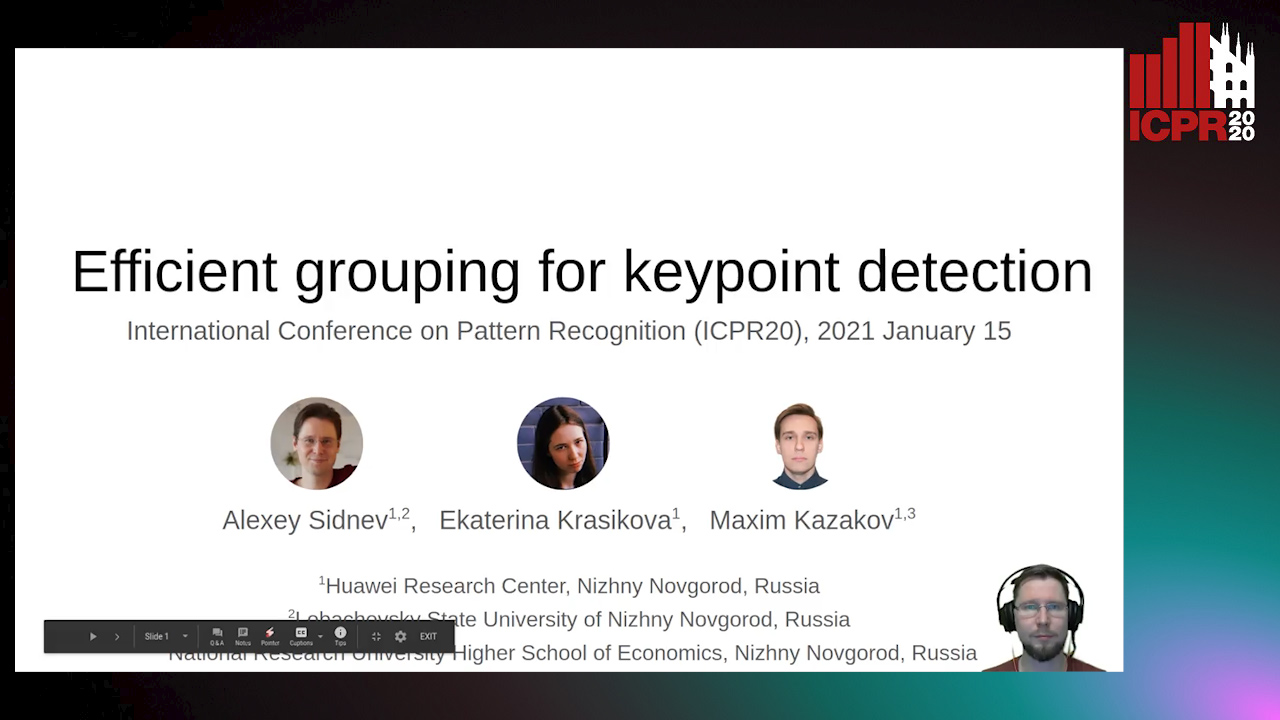
Auto-TLDR; Automatic Keypoint Grouping for DeepFashion2 Dataset
Abstract Slides Poster Similar
A Gated and Bifurcated Stacked U-Net Module for Document Image Dewarping
Hmrishav Bandyopadhyay, Tanmoy Dasgupta, Nibaran Das, Mita Nasipuri
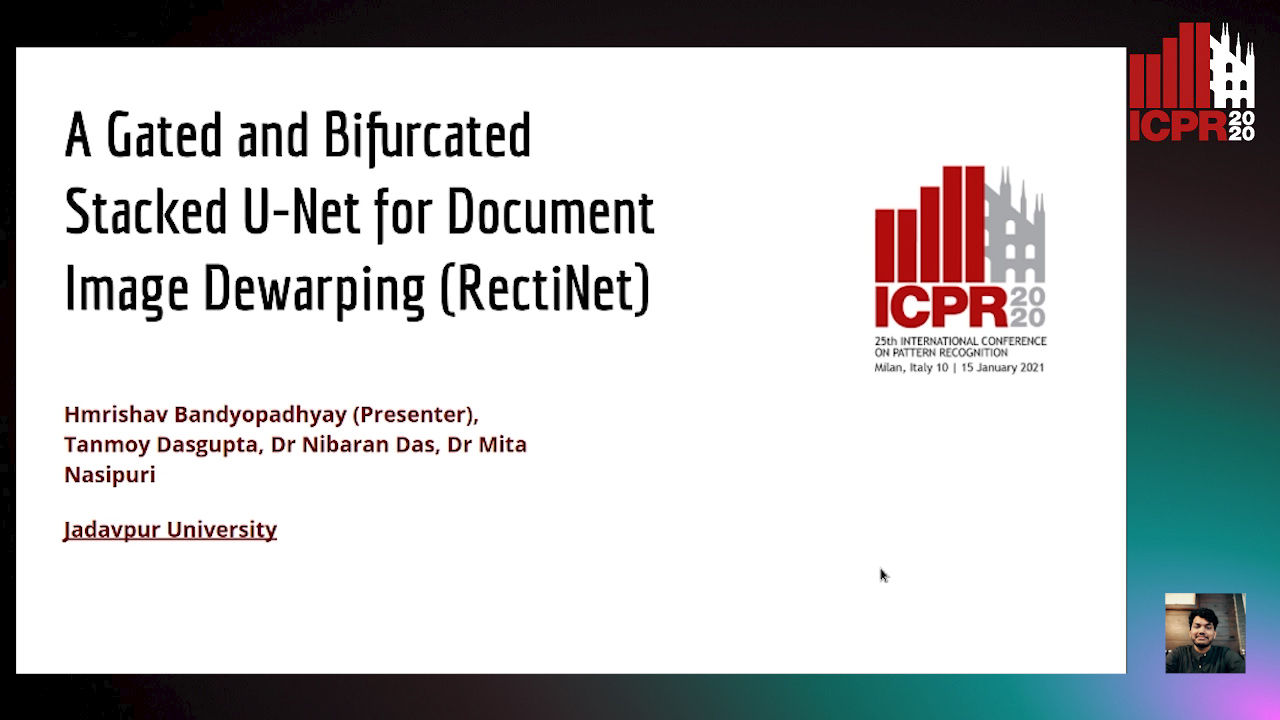
Auto-TLDR; Gated and Bifurcated Stacked U-Net for Dewarping Document Images
Abstract Slides Poster Similar
Light3DPose: Real-Time Multi-Person 3D Pose Estimation from Multiple Views
Alessio Elmi, Davide Mazzini, Pietro Tortella

Auto-TLDR; 3D Pose Estimation of Multiple People from a Few calibrated Camera Views using Deep Learning
Abstract Slides Poster Similar
Reinforcement Learning with Dual Attention Guided Graph Convolution for Relation Extraction
Zhixin Li, Yaru Sun, Suqin Tang, Canlong Zhang, Huifang Ma

Auto-TLDR; Dual Attention Graph Convolutional Network for Relation Extraction
Abstract Slides Poster Similar
Simple Multi-Resolution Representation Learning for Human Pose Estimation
Trung Tran Quang, Van Giang Nguyen, Daeyoung Kim

Auto-TLDR; Multi-resolution Heatmap Learning for Human Pose Estimation
Abstract Slides Poster Similar
Vision-Based Layout Detection from Scientific Literature Using Recurrent Convolutional Neural Networks

Auto-TLDR; Transfer Learning for Scientific Literature Layout Detection Using Convolutional Neural Networks
Abstract Slides Poster Similar
PIN: A Novel Parallel Interactive Network for Spoken Language Understanding
Peilin Zhou, Zhiqi Huang, Fenglin Liu, Yuexian Zou

Auto-TLDR; Parallel Interactive Network for Spoken Language Understanding
Abstract Slides Poster Similar
LODENet: A Holistic Approach to Offline Handwritten Chinese and Japanese Text Line Recognition
Huu Tin Hoang, Chun-Jen Peng, Hung Tran, Hung Le, Huy Hoang Nguyen
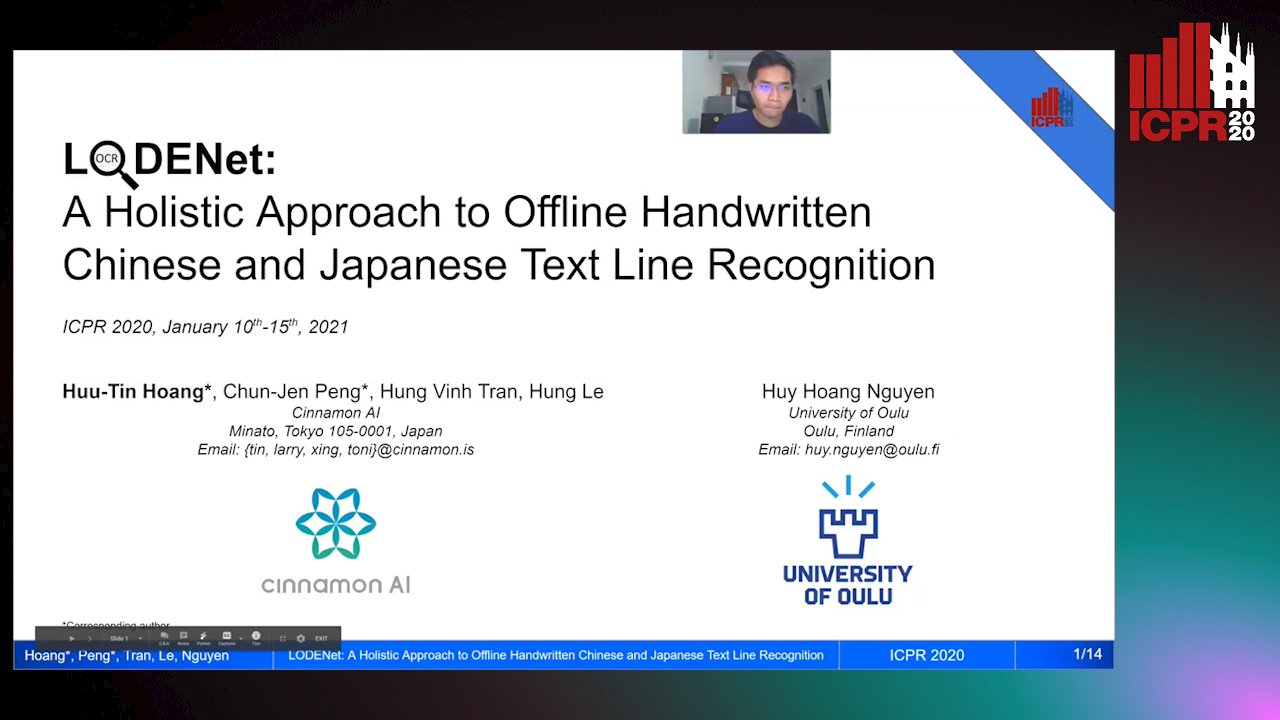
Auto-TLDR; Logographic DEComposition Encoding for Chinese and Japanese Text Line Recognition
Abstract Slides Poster Similar
CKG: Dynamic Representation Based on Context and Knowledge Graph
Xunzhu Tang, Tiezhu Sun, Rujie Zhu

Auto-TLDR; CKG: Dynamic Representation Based on Knowledge Graph for Language Sentences
Abstract Slides Poster Similar
RefiNet: 3D Human Pose Refinement with Depth Maps
Andrea D'Eusanio, Stefano Pini, Guido Borghi, Roberto Vezzani, Rita Cucchiara

Auto-TLDR; RefiNet: A Multi-stage Framework for 3D Human Pose Estimation
Using Scene Graphs for Detecting Visual Relationships
Anurag Tripathi, Siddharth Srivastava, Brejesh Lall, Santanu Chaudhury

Auto-TLDR; Relationship Detection using Context Aligned Scene Graph Embeddings
Abstract Slides Poster Similar
A Novel Attention-Based Aggregation Function to Combine Vision and Language
Matteo Stefanini, Marcella Cornia, Lorenzo Baraldi, Rita Cucchiara

Auto-TLDR; Fully-Attentive Reduction for Vision and Language
Abstract Slides Poster Similar
HPERL: 3D Human Pose Estimastion from RGB and LiDAR
Michael Fürst, Shriya T.P. Gupta, René Schuster, Oliver Wasenmüler, Didier Stricker

Auto-TLDR; 3D Human Pose Estimation Using RGB and LiDAR Using Weakly-Supervised Approach
Abstract Slides Poster Similar
A Grid-Based Representation for Human Action Recognition
Soufiane Lamghari, Guillaume-Alexandre Bilodeau, Nicolas Saunier

Auto-TLDR; GRAR: Grid-based Representation for Action Recognition in Videos
Abstract Slides Poster Similar
Scene Text Detection with Selected Anchors
Anna Zhu, Hang Du, Shengwu Xiong

Auto-TLDR; AS-RPN: Anchor Selection-based Region Proposal Network for Scene Text Detection
Abstract Slides Poster Similar
Cross-Supervised Joint-Event-Extraction with Heterogeneous Information Networks
Yue Wang, Zhuo Xu, Yao Wan, Lu Bai, Lixin Cui, Qian Zhao, Edwin Hancock, Philip Yu
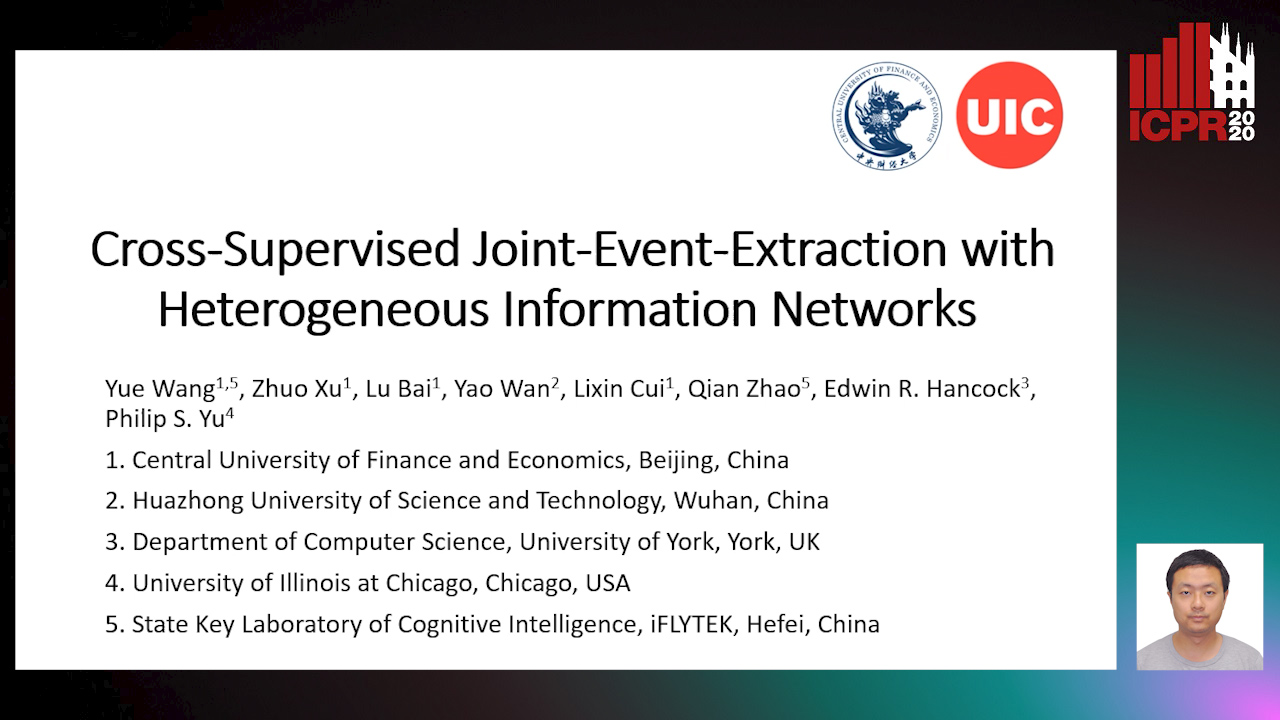
Auto-TLDR; Joint-Event-extraction from Unstructured corpora using Structural Information Network
Abstract Slides Poster Similar
Mutually Guided Dual-Task Network for Scene Text Detection
Mengbiao Zhao, Wei Feng, Fei Yin, Xu-Yao Zhang, Cheng-Lin Liu
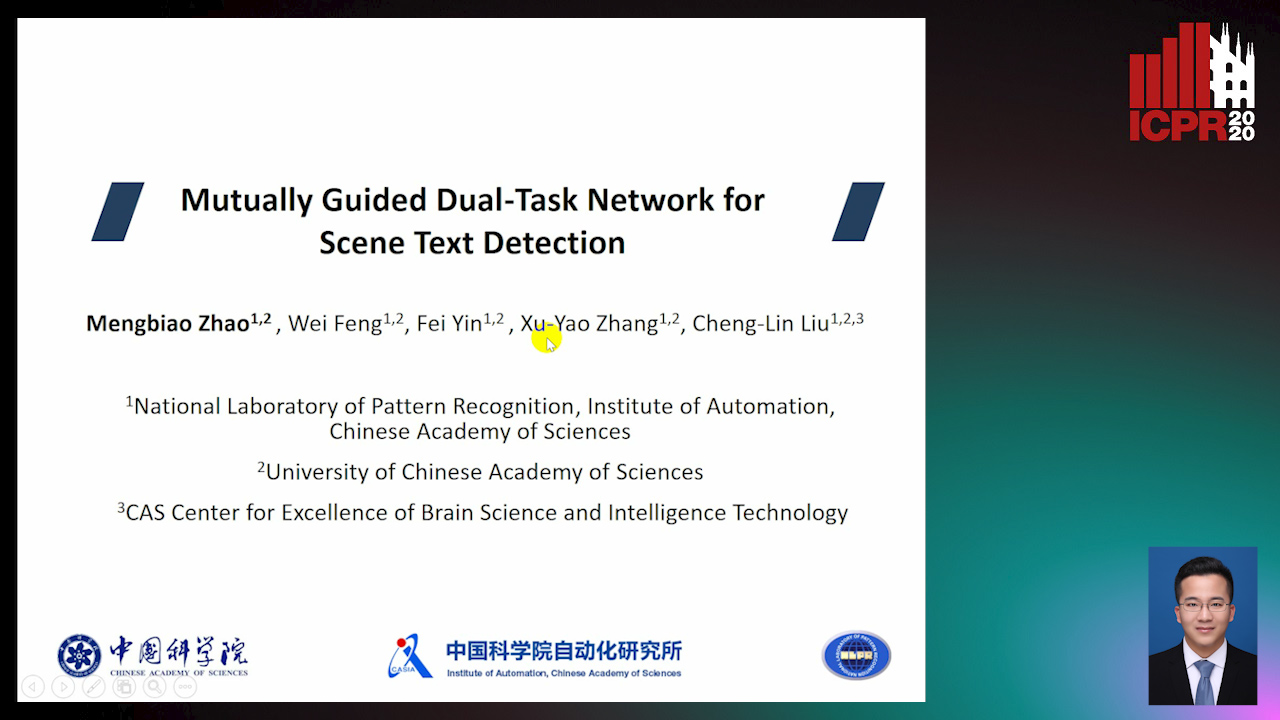
Auto-TLDR; A dual-task network for word-level and line-level text detection
GCNs-Based Context-Aware Short Text Similarity Model

Auto-TLDR; Context-Aware Graph Convolutional Network for Text Similarity
Abstract Slides Poster Similar
An Evaluation of DNN Architectures for Page Segmentation of Historical Newspapers
Manuel Burghardt, Bernhard Liebl

Auto-TLDR; Evaluation of Backbone Architectures for Optical Character Segmentation of Historical Documents
Abstract Slides Poster Similar
ConvMath : A Convolutional Sequence Network for Mathematical Expression Recognition
Zuoyu Yan, Xiaode Zhang, Liangcai Gao, Ke Yuan, Zhi Tang

Auto-TLDR; Convolutional Sequence Modeling for Mathematical Expressions Recognition
Abstract Slides Poster Similar
Visual Style Extraction from Chart Images for Chart Restyling
Danqing Huang, Jinpeng Wang, Guoxin Wang, Chin-Yew Lin

Auto-TLDR; Exploiting Visual Properties from Reference Chart Images for Chart Restyling
Abstract Slides Poster Similar
P2 Net: Augmented Parallel-Pyramid Net for Attention Guided Pose Estimation
Luanxuan Hou, Jie Cao, Yuan Zhao, Haifeng Shen, Jian Tang, Ran He

Auto-TLDR; Parallel-Pyramid Net with Partial Attention for Human Pose Estimation
Abstract Slides Poster Similar
ReADS: A Rectified Attentional Double Supervised Network for Scene Text Recognition
Qi Song, Qianyi Jiang, Xiaolin Wei, Nan Li, Rui Zhang

Auto-TLDR; ReADS: Rectified Attentional Double Supervised Network for General Scene Text Recognition
Abstract Slides Poster Similar
Revisiting Sequence-To-Sequence Video Object Segmentation with Multi-Task Loss and Skip-Memory
Fatemeh Azimi, Benjamin Bischke, Sebastian Palacio, Federico Raue, Jörn Hees, Andreas Dengel

Auto-TLDR; Sequence-to-Sequence Learning for Video Object Segmentation
Abstract Slides Poster Similar
Weakly Supervised Attention Rectification for Scene Text Recognition
Chengyu Gu, Shilin Wang, Yiwei Zhu, Zheng Huang, Kai Chen

Auto-TLDR; An auxiliary supervision branch for attention-based scene text recognition
Abstract Slides Poster Similar
Boundary-Aware Graph Convolution for Semantic Segmentation
Hanzhe Hu, Jinshi Cui, Jinshi Hongbin Zha

Auto-TLDR; Boundary-Aware Graph Convolution for Semantic Segmentation
Abstract Slides Poster Similar
Image-Based Table Cell Detection: A New Dataset and an Improved Detection Method
Dafeng Wei, Hongtao Lu, Yi Zhou, Kai Chen

Auto-TLDR; TableCell: A Semi-supervised Dataset for Table-wise Detection and Recognition
Abstract Slides Poster Similar
Improving Visual Relation Detection Using Depth Maps
Sahand Sharifzadeh, Sina Moayed Baharlou, Max Berrendorf, Rajat Koner, Volker Tresp
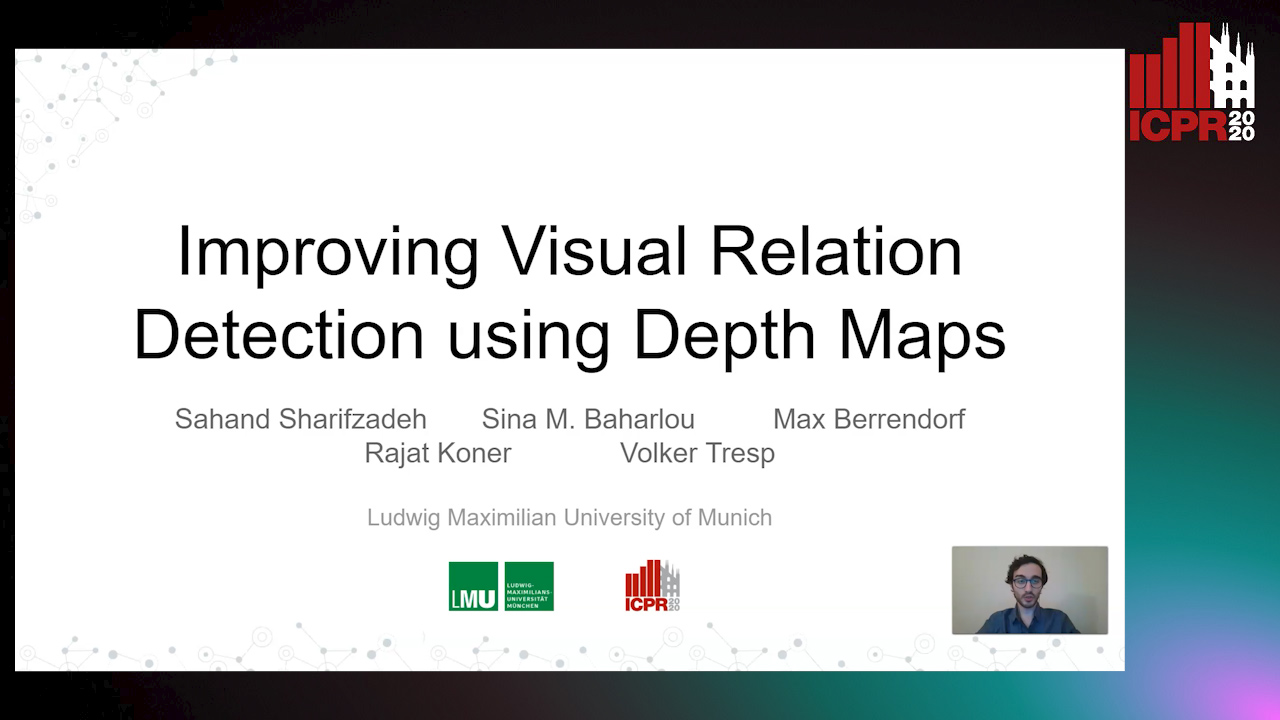
Auto-TLDR; Exploiting Depth Maps for Visual Relation Detection
Abstract Slides Poster Similar
Label Incorporated Graph Neural Networks for Text Classification
Yuan Xin, Linli Xu, Junliang Guo, Jiquan Li, Xin Sheng, Yuanyuan Zhou

Auto-TLDR; Graph Neural Networks for Semi-supervised Text Classification
Abstract Slides Poster Similar